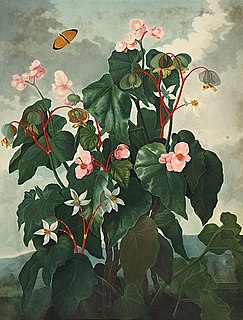
Begonia is a genus of perennial flowering plants in the family Begoniaceae. The genus contains more than 2,000 different plant species. The Begonias are native to moist subtropical and tropical climates. Some species are commonly grown indoors as ornamental houseplants in cooler climates. In cooler climates some species are cultivated outside in summertime for their bright colorful flowers, which have sepals but no petals.

Drosera peltata, commonly called the shield sundew or pale sundew, is a climbing or scrambling perennial tuberous species in the carnivorous plant genus Drosera. Among the tuberous sundews, D. peltata has the largest distribution, which includes eastern and western Australia, New Zealand, India, and most of Southeast Asia including the Philippines. The specific epithet is Latin for "shield shaped", a reference to the shape of the cauline leaves. It is either a single extremely variable species, or a complex of several closely related species of uncertain taxonomic boundaries. In Australia at least four forms have had or still have specific taxonomic recognition: Drosera peltata subsp. peltata, D. peltata subsp. auriculata, D. foliosa and D. gracilis.

The Appleseed Cast is an American rock band from Lawrence, Kansas. The band was founded in the early days of emo by singer-guitarist Christopher Crisci and drummer Louie Ruiz. The Appleseed Cast has steadily evolved over the release of eight full-length albums with Crisci as the main songwriter. The band has never broken up, but the lineup has changed over the years. Currently, the band's lineup includes Christopher Crisci, Ben Kimball, Nick Fredrickson, and Sean Bergman.
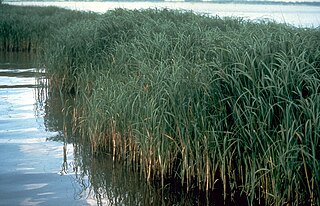
Sporobolus alterniflorus, or synonymously known as Spartina alterniflora, the smooth cordgrass, saltmarsh cordgrass, or salt-water cordgrass, is a perennial deciduous grass which is found in intertidal wetlands, especially estuarine salt marshes. It has been reclassified as Sporobolus alterniflorus after a taxonomic revision in 2014, but it is still common to see Spartina alterniflora and in 2019 an interdisciplinary team of experts coauthored a report published in the journal Ecology supporting Spartina as a genus. It grows 1–1.5 m tall and has smooth, hollow stems that bear leaves up to 20–60 cm long and 1.5 cm wide at their base, which are sharply tapered and bend down at their tips. Like its relative saltmeadow cordgrass S. patens, it produces flowers and seeds on only one side of the stalk. The flowers are a yellowish-green, turning brown by the winter. It has rhizoidal roots, which, when broken off, can result in vegetative asexual growth. The roots are an important food resource for snow geese. It can grow in low marsh as well as high marsh, but it is usually restricted to low marsh because it is outcompeted by salt meadow cordgrass in the high marsh. It grows in a wide range of salinities, from about 5 psu to marine, and has been described as the "single most important marsh plant species in the estuary" of Chesapeake Bay. It is described as intolerant of shade.
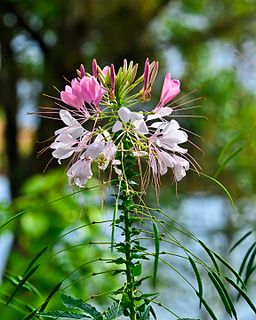
Cleome is a genus of flowering plants in the family Cleomaceae, commonly known as spider flowers, spider plants, spider weeds, or bee plants. Previously, it had been placed in the family Capparaceae, until DNA studies found the Cleomaceae genera to be more closely related to the Brassicaceae than the Capparaceae. Cleome and clammyweed, can sometimes be confused. The simplest way to differentiate the two is to compare the seedpods which project out or down on cleome and up on clammyweed.

The Mutisioideae are a subfamily in the plant family Asteraceae that includes about 630 species assigned to 44 different genera. This subfamily is mainly native in South America, except for Adenocaulon, Chaptalia, Gerbera, Trichocline, which have species in all continents other than Europe and Antarctica. Common characters are the deeply incised corollas of the disc florets, with five lobes, sometimes merged in two lips, flower heads with overlapping involucral bracts, anthers with tails and pointy tips, the styles usually stick far out of the florets and are essentially hairless. Most species are herbs, but some are vines, shrubs, or small trees.

Utricularia foliosa, the leafy bladderwort, is a large suspended aquatic carnivorous plant that belongs to the genus Utricularia. It is probably a perennial plant that cultivates in lake, swamps and ponds. U. foliosa is native to Africa and North and South America, widely distributed among many countries. Although, they are widely distributed around the world, very little studies have been contributed to U. foliosa. They like to sprout all year long, and found in large body of water. The environment that Utricularia foliosa are found in are experiencing negative anthropogenic impacts such as drainage and conversion to urban or agricultural activities are causing rapid environmental degradation.

Tussock grasses or bunch grasses are a group of grass species in the family Poaceae. They usually grow as singular plants in clumps, tufts, hummocks, or bunches, rather than forming a sod or lawn, in meadows, grasslands, and prairies. As perennial plants, most species live more than one season. Tussock grasses are often found as forage in pastures and ornamental grasses in gardens.

Calamagrostis foliosa is a species of grass known by the common name leafy reedgrass. It is endemic to northern California, where it grows in the forests and scrub on the coastline.

Dactylorhiza foliosa, the Madeira orchid or leafy orchid, is a species of flowering plant in the family Orchidaceae, endemic to the Portuguese Island of Madeira in the eastern Atlantic Ocean. It is a tuberous herbaceous perennial growing to 60 cm (24 in) and producing spikes of intense, magenta-pink flowers in late spring.
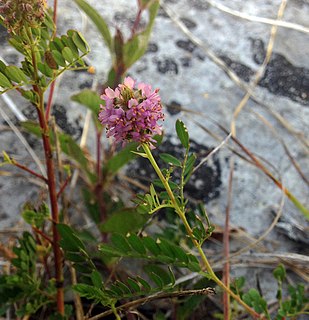
Dalea foliosa, commonly called leafy prairie clover, is a species of flowering plant in the legume family (Fabaceae). It is an endangered species in the United States, where it occurs in three states: Illinois, Tennessee, and Alabama.

Sporobolus foliosus is a species of grass known by the common name California cordgrass. It was reclassified from Spartina foliosa after a taxonomic revision in 2014. It is native to the salt marshes and mudflats of coastal California and Baja California, especially San Francisco Bay. It is a perennial grass growing from short rhizomes. It produces single stems or clumps of thick, fleshy stems that grow up to 1.5 meters tall. They are green or purple-tinged. The long, narrow leaves are flat or rolled inward. The inflorescence is a narrow, dense, spike-like stick of branches appressed together, the unit reaching up to 25 centimeters long. The lower spikelets are sometimes enclosed in the basal sheaths of upper leaves.

Poa foliosa is a species of tussock grass commonly known as muttonbird poa. It is native to the subantarctic islands of New Zealand and Australia.
Oonopsis foliosa is a species of flowering plant in the family Asteraceae known by the common name leafy false goldenweed. It is native to Wyoming and Colorado in the United States, where it occurs in the Rocky Mountain foothills and the edges of the Great Plains.
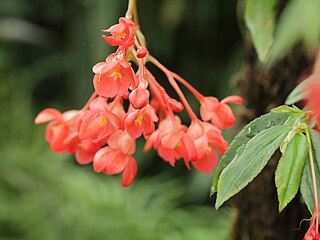
Begonia foliosa is a species of flowering plant in the family Begoniaceae, native to Colombia and Venezuela. It is a shrublike begonia growing to 1 metre (3.3 ft), bearing succulent, pendent stems 45 centimetres (18 in) long, thickly clothed with glossy oval green leaves, and producing panicles of small white flowers. The variety commonly cultivated is B. foliosa var. miniata with pink or red flowers. As it does not tolerate temperatures below 0 °C (32 °F), in temperate regions it requires winter protection.

Leucheria is a genus of flowering plants in the family Asteraceae.

The Nassauvieae are a tribe of flowering plants in the family Asteraceae.

Protea foliosa, also known as the leafy sugarbush, is a flowering plant of the genus Protea in the family Proteaceae which is endemic to the Cape Region of South Africa. In the Afrikaans language it is known as ruie-suikerbos.

Protea intonsa, also known as the tufted sugarbush, is a flowering plant of the genus Protea within the family Proteaceae, endemic to South Africa, where it is distributed from the eastern Swartberg and Kammanassie Mountains to the Baviaanskloof mountains. In Afrikaans it is known as klossie-suikerbos.
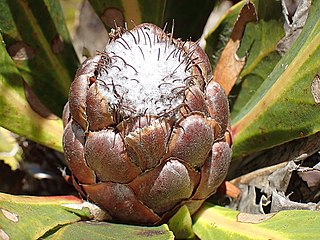
Protea vogtsiae, also known as the Kouga sugarbush, is a small flowering shrub of the genus Protea within the family Proteaceae, which is only found growing in the wild in the southern Cape Region of South Africa.


















